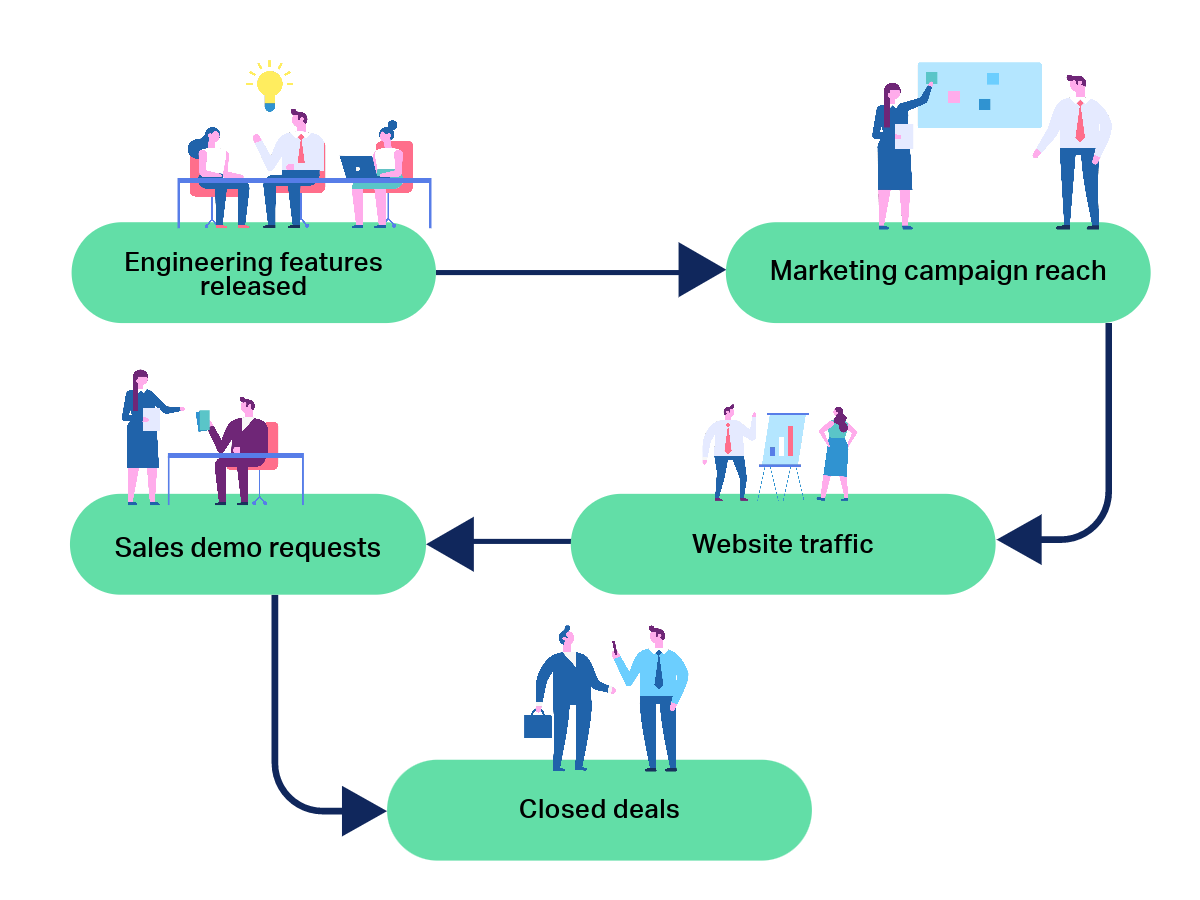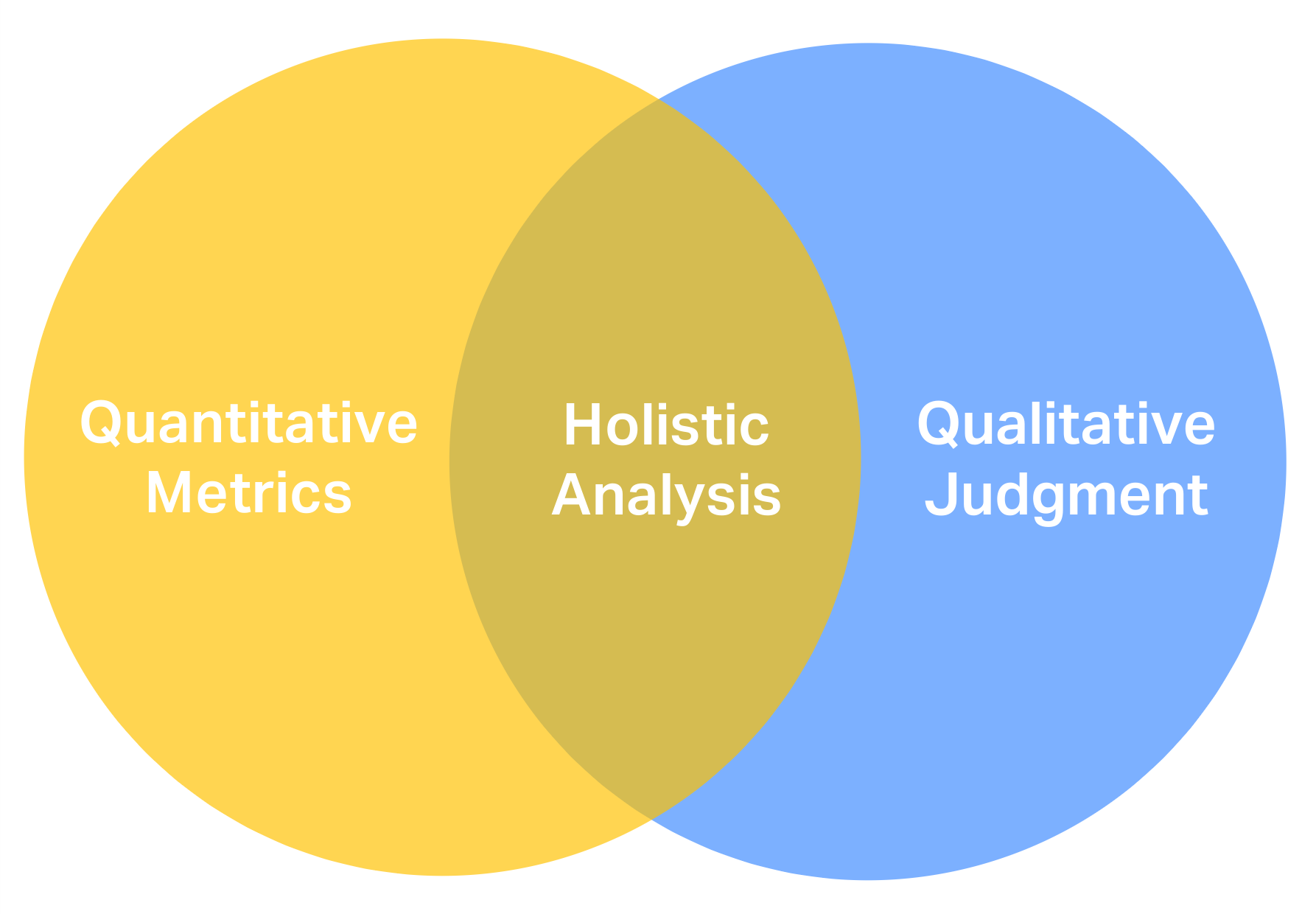
From Outputs to Outcomes: New Ways to Measure Product Success
- Product Leadership /
- Product Metrics /
Product teams face increasing demands to demonstrate return on investment (ROI) for their work. However, the ambiguity of research and innovation makes definitive ROI calculations near impossible. Common approaches like detailed time tracking and revenue attribution falter when applied to product development:
- Time tracking breeds inaccuracy as individuals guess time breakdowns across fluid collaborative work. It also incentivizes contradictory behaviors like time inflation.
- Attributing revenue to specific product features dramatically oversimplifies how broader factors like brand and market conditions influence revenue. It can also motivate short-term thinking.
For teams with deep dysfunction issues, investing great efforts into finely tuned ROI spreadsheets provides little value. Unless core problems are addressed, advanced metrics are pointless.
Product teams need new frameworks to link their investments to business outcomes. Rather than tracking utilization or allocating revenue precisely, they should focus on the key inputs under their control and how those tie to sustainable results and impact their customers.
This article examines why prevailing ROI approaches fall short in quantifying product development. It proposes principles to guide teams toward a more effective way to think about ROI. While perfect ROI metrics are futile, redirecting efforts toward meaningful outcomes and customer impact versus false precision can improve insights. Product teams must evolve beyond the spreadsheet.
Examining Common Product ROI Failings
Attempts to quantify ROI in product development often go awry. Two common approaches – time tracking tools and revenue attribution – seem logical but have significant flaws in practice:
Time Tracking
Many teams try to allocate time spent on specific projects to determine ROI. However, accurately tracking time use across complex and collaborative activities is futile. Individuals end up arbitrarily guessing time breakdowns and the time invested by cross dependent teams, leading to questionable data.
For example, engineers at one of our SaaS client companies were asked to track hours spent on different projects. With no time accounting system, they admitted most percentages were rough estimates. The resulting data showed a clean 50/50 split between two main projects – an improbable outcome revealing the unreliable nature of manual time tracking.
Time tracking also incentivizes bad behavior, as teams inflate hours to show greater “utilization.” Product development relies on fluid collaboration between disciplines. Attempts to atomize efforts into hours undermine this. The arbitrary quality of collaborative time also means raw hour counts reveal little without examining in depth the context of the activity to provide a true apples to apples comparison.
Revenue Attribution
Attributing revenue dollars to specific product changes is another common tactic. However, this dramatically oversimplifies the dynamics of how revenue is generated. Revenue depends on many factors beyond individual product changes, like brand, sales capabilities, and market conditions.
For example, when the same SaaS company launched a new premium product offering, half of the revenue was attributed to the engineer who developed the core feature. However, this ignored the brand equity, consumer insight, established sales channels, and pricing team contributions that were essential in driving the revenue performance.
Attributing revenue dollars also often motivates short-term thinking. Teams may push quick hits over sustained impact in order to get “credit.” It also pushes monetization of every possible product change rather than delivering holistic customer value.

Shifting Mindsets: Key Principles for Product Teams Seeking Better ROI Frameworks
As we’ve seen, traditional product development ROI approaches like detailed time tracking and revenue attribution are fundamentally flawed. They breed inaccuracy, misaligned incentives, oversimplification, and can promote short-term thinking.
Yet the desire from leadership to better understand ROI is unlikely to disappear and is inherently essential. Product teams will continue facing pressure to demonstrate how their investments and activities tie back to tangible business outcomes.
Rather than repeatedly apply ineffective methods, product teams need to reframe how they approach the challenge. New frameworks are required before teams can make progress quantifying the ambiguous work of innovation.
While prevailing ROI approaches fall short, some guiding principles can help teams develop better frameworks:
- Focus on Team Outputs
Rather than individual time allocation, assess the outputs and outcomes achieved by entire teams. This reflects the collaborative reality of product work. Consider team capacity allocated to company objectives, not utilization rates. - Invest in Capabilities
Separate investment in people and capabilities from short-term project spending. Building talent and skills has a future payoff not captured in quarterly expenditures. - Embrace Throughput Accounting
When dependencies are high between teams, take a throughput accounting view. Optimize the end-to-end value flow rather than isolating team efforts. - Treat Teams as Business Units
Mature, independent teams can be measured like business units, assessing outcomes they control that contribute to revenue and growth. But ensure the team truly has ownership and autonomy. - Prioritize Sustainable Results
Avoid false precision and focus on actions tied to sustainable long-term results. Outcomes like customer satisfaction and engaged employees contribute to success.
The key is shifting team mindsets before applying new frameworks. Product groups must move from tracking utilization to assessing outcomes, and from outputs to capabilities. This reorientation sets the stage for better ROI insights.
How to Build a Team-Focused Model for Product ROI Measurement
With the right principles in mind, teams can develop frameworks to better understand ROI:
Map Team Inputs to Outputs
Identify key inputs that teams can control, like product experiments run or capabilities built. Map how those inputs translate to outputs like features shipped.
For example, your UX team might have identified “user research interviews conducted” as a key input they could control. They committed to run 15 user interviews per month. The UX designers mapped this input to outputs like:
- Key user needs validated
- 2 documented user flows based on findings
- 4 new interface concepts prototyped
This enabled them to connect the controllable team input of user research to downstream outputs like requirements validated, prototypes created, and knowledge gained. Over time they could evaluate how more research interviews influenced the usefulness of their design outputs.
Mapping inputs to outputs provided better visibility into how the team’s activities influenced downstream deliverables. It created clearer connections between cause and effect.
Link Outputs to Inputs that Support Cross-Functional Team Success
Connect how outputs from one team flow as inputs to others. Feature releases input to marketing campaigns which input to sales.
For example, your engineering team might measure the output of features released per month. They track how this output feeds as a key input into the marketing team’s ability to launch promotional campaigns highlighting the new features.
The marketing team then tracks the campaign reach as a controllable input that flows to increased website traffic. More traffic feeds into higher sales demo requests, which the sales team sees as a key input driving their closed deals.
By linking outputs and inputs in this way, the teams establish a visible chain of value:

This interlocking flow helps connect team outputs to broader business outcomes. Rather than siloed metrics, it creates a narrative tying contributors to results.
Relate Outputs to Outcomes
Link outputs to broader outcomes like revenue, customer retention, and brand growth. Consider long time horizons, as outcomes reflect years of inputs.
For example, your product team might have started tracking the output of weekly active users gained from new feature launches. They could correlate this output to the outcome of increased customer renewal rates over time.
By analyzing the data, they found that a 10% increase in active users typically flowed into a 2% rise in renewal rates 6 months later. This allowed them to connect the near-term output metric to the longer-term business outcome.
Mapping these relationships required looking at multi-year horizons to see the downstream impacts. Outcomes like revenue, retention, and brand preference are lagging indicators that play out over years, not quarters. But making these connections provided crucial visibility into how today’s outputs influence tomorrow’s results.
Assess Health of Delivery
Measure overall health of the development process. How much time is spent resolving technical debt versus new work? How frequently do releases flow through?
For example, your engineering team might have found that their velocity was slowing despite team growth. By assessing the delivery process, they discovered:
- 30% of recent sprints were spent on technical debt and bugs
- Release cycles had expanded from bi-weekly to once every 6 weeks
- Teams relied on 3 legacy systems that caused integration headaches
These assessments revealed unhealthy delivery dynamics despite more engineers being hired. It led them to prioritize tech debt reduction and implement DevOps practices like CI/CD.
Over time, the engineering group improved their release rhythm to bi-weekly again. Time spent on technical debt decreased to only 15%. And new feature work resumed its previous velocity.
By measuring the overall delivery health, teams can identify bottlenecks like legacy tech, uneven quality, and slow processes. This highlights crucial inefficiencies that handicap productivity.
Tie to Business Results
Anchor teams to the business results they ultimately influence. Even if indirect, establish line of sight from team actions to outcomes.
For example, your analytics team might have identified increased customer lifetime value (LTV) as a key business objective. They worked backwards to map their inputs to this goal:
- Optimize recommendation engine algorithms (input)
- Improve content relevance for users (output)
- Increase per-user content engagement (output)
- Extend user subscription tenures (outcome)
- Increase overall customer LTV (result)
Even though optimizing algorithms was far removed from LTV, this created a clear line of sight between their daily work and overarching business needs.
In a monthly review, they tie recent input metrics like algorithms improved to output metrics like engagement increased. This demonstrates their impact on outcomes like lower churn and elevated lifetime value.
Connecting teams to enterprise results in this way keeps them grounded in the “why” behind their work. It reinforces how their piece fits into the larger puzzle.
Refine with Team Maturity
As teams mature from tightly coupled to more independent, ROI measurement approaches can evolve appropriately.
For example, you might form a new team as a new product incubator inside your company. They were heavily dependent on shared services like data, legal, support etc. from other groups.
With these tight dependencies, throughput accounting was most relevant early on. Measuring value flow through the overall system mattered more than isolated team metrics.
After 2 years, the team has established their own data resources, support processes etc. They became a more distinct business unit inside the parent company.
With this independence, ROI and impact could now be measured more at the team level through metrics like:
- Revenue relative to targets
- Marketing spend efficiency
- Net Promoter Score
- Customer retention
The key is matching ROI approaches to the stage of team maturity and autonomy. Shared system throughput makes sense for new dependent teams; business metrics fit mature standalone teams.
Moving Past Measurement in Product Work
While team-focused frameworks can certainly improve upon approaches like time tracking and revenue attribution, even the best models have limitations. When dealing with something as complex and ambiguous as product development, perfection in quantifying ROI is impossible.
At the end of the day, no framework can provide complete certainty or accuracy. Even as teams work to implement more effective methods, they must recognize the that measurement methods need to be iterated:
- Inputs Evolve with Maturity
Early stage teams need different input metrics versus mature teams. Startups may focus more on validating problem-solution fit versus revenue-driven teams. - Reflect on Contributions
Regularly reflect on how work contributes to the business, even without hard metrics. Consider different perspectives on the value created. - No Perfect Answers
Ambiguity is the price of innovative work. Strive for useful insight on ROI, but don’t get lost in analysis paralysis seeking the “right” metrics. - Focus on Judgement
Even with helpful frameworks, ROI understanding relies on seasoned judgment. Experience guides interpretation of metrics and recognizing distortions. - Stay Grounded in Why
Revisit how the team’s purpose connects to business goals. This grounds metrics in meaning rather than pursuing measures for their own sake.

The core team behavior of relentlessly delivering value matters more than any particular ROI metric. Perception of value depends heavily on the beholder. While better frameworks can improve conversations, meaningful insights require experience and wisdom to properly contextualize.
Valuing Insights Over Metrics in Product Work
Product teams will continue facing challenges demonstrating ROI for their efforts. Approaches like detailed time tracking and revenue attribution have inherent flaws and steer behaviors in unproductive directions.
Thoughtful frameworks like throughput accounting and mapping team inputs to outcomes can provide better insights. However, even the best models have limits quantifying something as ambiguous as product development.
Seasoned judgment and a mindset focused on long-term value outweigh any model or metric. Despite progress, some uncertainty will remain in conveying ROI for innovative product work.
The quest for perfect measurement is futile. However, teams can have more meaningful conversations about investment and outcomes by:
- Shifting focus from utilization rates to business impacts
- Applying team-centered throughput principles
- Relating controllable inputs to sustainable results
- Investing in capabilities beyond short-term outputs
- Grounding in the purpose, not pursuing metrics for their own sake
By combining frameworks, experienced interpretation, and a value-driven culture, product teams can better convey ROI while avoiding the perils of false precision. Rather than drowning in flawed analytics, they can devote more energy to tackling why their work matters.